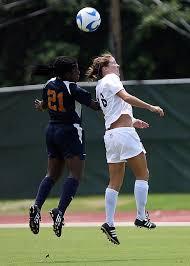Results of a new study released this week about soccer, and the effects that "heading" the ball has on the brain, delivered one key takeaway message: women's brain matter appears to be more sensitive than men's.
While this may be true, it's important that we be somewhat cautious in making too much of this, given the way the study was conducted as well as how the conclusions are being repeated, and somewhat exaggerated when reported in the media.
A team of U.S. researchers sought to determine whether player gender played a role when measuring the impact of subconcussive hits when players "head" the ball, or change its direction by using it as a tool.
They got equal numbers of men and women to participate in the study; these players had roughly the same history and experience playing soccer; and they estimated the number of times each player headed the ball the previous year, totals of which were nearly the same. And all players were given MRIs, called diffusion tensor imaging, to measure changes in the brain's white matter, tissue responsible for communication between different regions of the brain.
The one finding that's receiving the greatest attention is that from nearly the same exposure to heading, the volume of damaged white matter in women's brains was five times more than what occurred in men's brains. Or as the authors wrote in their paper, which appeared online in the journal Radiology, "The fivefold greater volume of affected white matter that we identified in women compared with men pointed to a higher burden of microstructural consequences in female headers."
However, this is derived from research conducted that includes several limitations.
There were only 98 players studied, 49 male and 49 female. Researchers didn't witness the headers that the players said they received over the previous year, since the data was (1) self-reported, and (2) a result of guesswork and estimates. In addition, there was no method used to isolate whether these subconcussive hits to the head were a result of hitting the ball, hitting an opponent's head while attempting to head the ball, or from a head collision with the playing field or turf.
So while the headlines you may read, regarding the dramatic 5X difference in "damage" suffered between men and women, there's no way to know whether this figure is somewhat valid, if at all. Brain researchers have known that the effects of concussions on women are generally greater than those suffered by men, but this study isn't about concussions, either.
Therefore, the results are murky, at best, which the authors plainly acknowledge in the paper's summary section: "Our study provides preliminary support to the notion that women are more sensitive to repetitive subconcussive head impacts at the level of brain tissue microstructure." Note the word preliminary.
While the study provides some insight – some – to what happens when women players use their heads on the soccer pitch, in no way should it be construed that based on this study and sample size that they're at five times greater risk of suffering some damage to white brain matter than male players.




